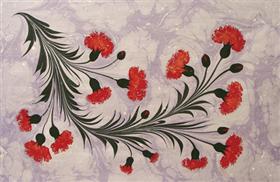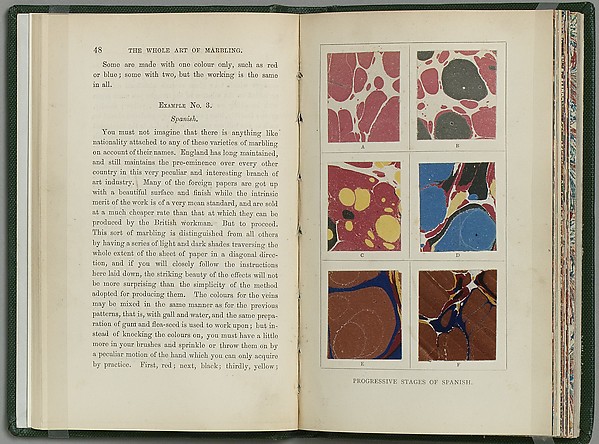
"The Art of Ebru Paper Marbling"
THE WESTERN DISCOVERY OF EBRU

The first marbling methods were developed in the East when Chinese and Japanese
artists began to decorate paper. The form of marbling that was first discovered
by Western travelers to the East, is called "Ebru" paper marbling and
was developed in Turkey between the 15th and 16th century during the Golden Age of the Ottoman Empire.
Historically, the Turkish stone pattern is the
oldest of Western marbled patterns. Scholars maintain that this pattern had reached Europe
as early as the 1400's, although there are
no known dated Ebru works. One of the earliest documented
sheets of
marbled paper dates from 1447 and comes from Turkey (see Historical
Book Arts).
Not many people are aware of the role that Turkish Ebru marbling played in the everyday lives of Europeans, and later in the Western world. After this form of art was discovered by Europeans in Istanbul (previously Constantinople, the capital of Byzantium) during the 1500's, the immense contribution that Ebru marbling made to the overall history of the book has often not been fully appreciated, except by individuals who are active in the antiquarian book trade, or involved with research libraries.
Paper historians maintain that European marbling seems to have begun as early as the 16th Century, although Turkish papers were being imported before that time. Because the history of European marbling consists of individual countries and individual masters, it has been said that “attempting to reconstruct European marbling history is very much like working an old jigsaw puzzle, some of whose pieces are lost, some disfigured, some misplaced, and others still not turned right side up.”* The 1604 German Album Amicorum is one of the earliest known examples of European marbling.
In England, marbling was spurred by travel. In A Relation of a Journey Begun in 1610 by George Sandys, the author describes the marbling process that he observes in Turkey. This book first appeared in 1615. In Sylva Sylvarum published in 1627, Sir Francis Bacon also mentions Turkish paper marbling. Sir Thomas Herbert, a diplomat observed the marbling process in Persia and wrote about Ebru in Some years travels into divers parts of Africa, and Asia the Great: Describing more particularly the empires of Persia and Industan, which first appeared in 1634.
In addition, the unique methods of marbling attracted the curiosity of early scientists during the Renaissance. While the earliest published account was written in German by Daniel Schwenter, it was not published in his Delicæ Physico-Mathematicæ until 1671. A brief description of the art, which rapidly spread throughout Europe, was published in Rome in 1646 by Athanasius Kircher, in Ars Magna Lucis et Umbræ. A thorough overview of the art with illustrations of marblers at work, and images of the tools of the trade, was published in the Encyclopédie of Denis Diderot and Jean le Rond d'Alembert. The art became a popular handicraft in the 19th century after the Englishman Charles Woolnough published The Art of Marbling in 1853. The author describes how he adapted a method of marbling onto book-cloth, which he exhibited at the Crystal Palace Exhibition in 1851. Further contributions to the art of marbling were made by Josef Halfer, a bookbinder of German origin, who lived in Budakeszi, Hungary. After the publication of his book Die Fortschritte der Marmorierkunst, translations were made into many languages, and his work reached the U.S. It was Halfer who discovered a method for preserving carrageenan, and his methods superseded earlier ones in Europe and the U.S.
The first book to provide a history of marbled paper in Europe is Decorated Book Papers by Rosamond B. Loring, published in 1942. Loring was a paper scholar, a skilled maker of marbled and paste papers, and a collector. Having trained as a bookbinder, Loring experimented with making decorated papers for her own use and received early instruction in the art of marbling from Charles V. Saflund (a distinguished teacher of marbling and paste paper techniques). Loring's personal collection now resides at the Rosamond B. Loring Collection of Decorated Papers in the Department of Printing and Graphic Arts at Houghton Library, Harvard University.
It should be noted that other forms of paper decoration include paste papers and printed papers. In the former, binders paste is mixed with color and then paper, or the edges of books are brushed or daubed with paste. Designs in the paste are created by drawing with a tool or a finger through the paste, or using a variety of tools pressed into the paste. (Note: printed papers consist of printed images on paper—the one form that produces papers that are identical. All other processes mentioned above are done by hand and are, therefore, unique)
*Source: Lib.washington.edu
Wolfe,
Richard J. Marbled
Paper: Its History, Techniques, and Patterns: With Special Reference to the
Relationship of Marbling to Bookbinding in Europe and the Western World.
University of Pennsylvania Press, 1990.
Diderot, Denis, and Jean le Rond D'Alembert, eds. "Marbreur de papier". L'Encyclopédie, ou dictionnaire raisonné des sciences, des arts et des métiers." University of Chicago: Collaborative Translation Project.
DIFFICULTIES OF THE TRADE
Marbling Spreads to Europe
But Remains A Trade Secret Until
The 19th Century
In eighteenth-century France, marbling was given wider currency by the great French rationalist Denis Diderot, chief editor of the Encyclopédie. Appalled by a reactionary church and state that suppressed art and science, Diderot enlisted artists and men of letters from throughout France. Together they wrote an encyclopedia, a summary of art and science, as they knew it, convinced that scientific information would loosen the stranglehold of superstition and dogma—a point not lost upon the church and state, which directed Diderot to prison for three months. Nonetheless, the 28 volumes of the Encyclopedia were published between 1751 and 1772. Included were detailed descriptions of the art of marbling, and line drawings of marblers at work.
In England, knowledge of marbling was suppressed less by decree than by the determined secrecy of craftsmen themselves. By the early nineteenth century, books with marbled end papers were popular enough to support a thriving industry. Marbling houses operated on the apprentice system. The master would search for boys that could work long hours in exchange for what passed as bed and board, under conditions reminiscent of the works of Charles Dickens. In return, the master promised to teach the boys his trade. In actuality, this was not the case.* Unwilling to train his future competition, the master taught each boy only one step in the process: how to make the bath, or how to grind the paints, or how to execute a pattern. Workstations were separated by screens, and some apprentice marblers were forced to work behind wooden partitions, so no one could see anyone else. When the boys completed their seven-year apprenticeship, they were turned into the streets. Finally, in 1853, an Englishman revealed the secrets of marbling in his book The Art of Marbling. The one to call the game was Charles Woolnough, a self-taught marbler who took a dim view of artistic secrecy, and the exploitation of children. In 1853 he braved the wrath of his fellow marblers when he published The Art of Marbling—a textbook that described all phrases of the process.
As the nineteenth century drew to a close, and book production became mechanized, marbling faded into obscurity. Yet, no one has managed, to eliminate the individual artist from the art of marbling. The art remained a curiosity in antique books until the late 1970's, when the crafts movement spotlighted the beauty of this art, the methods of fine craftsmanship, and the value of handwork.
*Source: Library.leeds.ac.uk
The Whole Art of Marbling written by Charles Woolnough

Perhaps the most important book on British marbling, "The Whole Art of Marbling" provides a detailed account of the methods and materials of the craft of marbling and gives instructions for making approximately thirty traditional and "modern" patterns.
L'Encyclopedie, 1751-1757 Entitled Marbreur de Papier (Paper Marbler)
Plate above shows paper marbling process and tools - Engraving from Denis Diderot, Jean Baptiste Le Rond d'Alembert